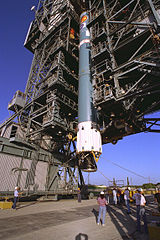RS-27
 | |
| Kraj pochodzenia | |
|---|---|
| Projektant | Rocketdyne |
| Wykorzystanie | Thor-ELT (Delta 2000, Delta 3000, Delta 5000), Thor-XLT (Delta II 6000) |
| Materiały napędowe | nafta, ciekły tlen |
| Pierwszy lot | 19 stycznia 1974 |
| Ostatni lot | 24 lipca 1992 |
| Osiągi | |
| Siła ciągu na poziomie morza | 971 kN |
| Siła ciągu w próżni | 1023 kN |
| Impuls właściwy na poz. morza | 264 s |
| Impuls właściwy w próżni | 295 s |
| Maks. czas działania | 274 s |
| Parametry | |
| Komory spalania | 1 |
| Ciśnienie w komorze | 49 bar |
| Wymiary | |
| Długość | 3,63 m |
| Średnica | 1,07 m |
| Masa | 1027 kg |
 Silnik RS-27A przymocowany do stopnia Thor-XLT rakiety Delta II | |
| Kraj pochodzenia | |
|---|---|
| Projektant | Pratt & Whitney Rocketdyne |
| Wykorzystanie | Thor-XLT (Delta II 7000, Delta III) |
| Materiały napędowe | nafta, ciekły tlen |
| Pierwszy lot | 26 listopada 1990 |
| Ostatni lot | 10 września 2011 |
| Osiągi | |
| Siła ciągu na poziomie morza | 890,1 kN |
| Siła ciągu w próżni | 1054,2 kN |
| Impuls właściwy na poz. morza | 255 s |
| Impuls właściwy w próżni | 302 s |
| Maks. czas działania | 265 s |
| Parametry | |
| Komory spalania | 1 |
| Ciśnienie w komorze | 48 bar |
| Stosunek ciągu do masy | 102:47 |
| Wymiary | |
| Długość | 3,78 m |
| Średnica | 1,70 m |
| Masa | 1147 kg |
RS-27 – amerykański silnik rakietowy zasilany paliwem ciekłym, produkowany przez Rocketdyne i wykorzystywany do zasilania pierwszych stopni rakiet Delta 2000, Delta 3000, Delta 5000, a także pierwszej serii rakiet Delta II (6000).
Silnik ten jest technologicznym rozwinięciem silnika H-1, używanego do napędzania rakiet Saturn I oraz Saturn IB. Powstał w celu zastąpienia silników MB-3, wykorzystywanych we wcześniejszych wersjach rakiet Delta[1][2]. W późniejszych latach na bazie RS-27 zostały zbudowane silniki RS-27A, przeznaczony dla rakiet Delta II (7000) oraz Delta III[3][4], a także RS-56, wykorzystywany w rakietach Atlas II[5].
Przypisy
- ↑ RS-27. Astronautix. [dostęp 2016-08-13].
- ↑ Delta. Astronautix. [dostęp 2016-08-13].
- ↑ Extended Long Tank Thor Delta. Space Launch Report. [dostęp 2016-08-13].
- ↑ RS-27A. Astronautix. [dostęp 2016-08-13].
- ↑ Atlas IIA(S) Data Sheet. Space Launch Report. [dostęp 2016-08-13].
Media użyte na tej stronie
The flag of Navassa Island is simply the United States flag. It does not have a "local" flag or "unofficial" flag; it is an uninhabited island. The version with a profile view was based on Flags of the World and as a fictional design has no status warranting a place on any Wiki. It was made up by a random person with no connection to the island, it has never flown on the island, and it has never received any sort of recognition or validation by any authority. The person quoted on that page has no authority to bestow a flag, "unofficial" or otherwise, on the island.
On Launch Pad 17-B at Cape Canaveral Air Force Station in Florida, workers check the lines attached to the lower end of the United Launch Alliance Delta II rocket before it is lifted into the mobile service tower. The rocket is the launch vehicle for the THEMIS spacecraft, consisting of five identical probes, the largest number of scientific satellites ever launched into orbit aboard a single rocket. This unique constellation of satellites will resolve the tantalizing mystery of what causes the spectacular sudden brightening of the aurora borealis and aurora australis - the fiery skies over the Earth's northern and southern polar regions. After the first stage is in the mobile service tower on the pad, nine solid rocket boosters will be placed around the base of the first stage and attached in sets of three. THEMIS is scheduled to launch aboard the Delta II at 6:07 p.m. EST on Feb. 15.


